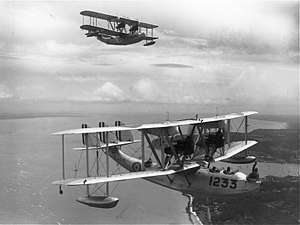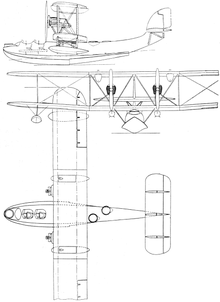Supermarine Southampton
| Supermarine Southampton | |
|---|---|
 | |
| Role | Military reconnaissance flying boat |
| Manufacturer | Supermarine |
| First flight | 10 March 1925 |
| Introduction | 1925 |
| Primary user | Royal Air Force |
| Produced | 1924–1934 |
| Number built | 83 |
| Developed from | Supermarine Swan |
| Variants | Saunders A.14 Hiro H2H Supermarine Scapa |
The Supermarine Southampton was a 1920s British flying boat, one of the most successful flying boats of the interwar period. It was a development of the Supermarine Swan, which was used for a ten-passenger service between England and France.
Design and development
The Southampton was designed by the team of R. J. Mitchell, better known as the designer of the later Spitfire. Due to the success of the Swan, the Air Ministry ordered six Southamptons direct from the drawing board, which was unusual. As the Swan had acted in effect as a prototype, development time was short.
The Southampton was a twin-engine biplane flying boat, with the tractor engines mounted between the wings. The Southampton Mk I had both its hull and its wings manufactured from wood. The Southampton Mk II had a hull with a single thickness of metal (duralumin) (the Mk I had a double wooden bottom). This change gave a weight saving of 900 lb (409 kg) allowing for an increase in range of approximately 200 mi (320 km). In 1929, 24 of the Mk I were converted by having newly built metal hulls replacing the wooden ones. Some of the later aircraft were built with metal wings and were probably designated as Southampton Mk III. There were three positions for machine guns, one in the nose and two staggered in the rear fuselage.
The first flight of a production aircraft was made on 10 March 1925, and delivery to the RAF started in mid-1925.
Operational history
Southamptons first entered RAF service in August 1925 with No. 480 (Coastal Reconnaissance) Flight at RAF Calshot. In a series of "showing the flag" flights, the type quickly became famous for long-distance formation flights; the most notable was a 43,500 km (27,000 mi) expedition in 1927 and 1928. It was carried out by four Southamptons of the Far East Flight, setting out from Felixstowe via the Mediterranean and India to Singapore.
Further Southamptons were sold to a number of other countries. Eight new aircraft were sold to Argentina, with Turkey purchasing six aircraft and Australia buying two ex-RAF Mk 1 aircraft. Japan also purchased a single aircraft which was later converted into an 18-passenger cabin airliner. One RAF aircraft was loaned to Imperial Airways, with British Civil Registration G-AASH, for three months from December 1929 to replace a crashed Short Calcutta on the airmail run between Genoa and Alexandria.[1] In all, 83 Southamptons were constructed, excluding the three-engined Southampton MK X which was a single prototype.[2]
Variants
Different powerplants were fitted in variants:
- Mk I
- Napier Lion V engine, wooden hull. 23 built.[3]
- Mk II
- Napier Lion Va, 39 built[4]
- Saunders A.14
- Argentina
- Lorraine-Dietrich 12E. Five wooden-hulled + three metal-hulled aircraft.[3]
- Turkey
- Hispano-Suiza 12Nbr. Six built.[2]
- Bristol Jupiter IX and Rolls-Royce Kestrel in experiments
- Mk IV Supermarine Scapa prototype
Operators
.jpg)
Military operators
- Royal Australian Air Force
- No. 1 Flying Training School's Seaplane Squadron RAAF
- Royal Air Force [5]
- No. 201 Squadron RAF
- No. 203 Squadron RAF
- No. 204 Squadron RAF
- No. 205 Squadron RAF
- No. 209 Squadron RAF
- No. 210 Squadron RAF
- No. 480 (Coastal Reconnaissance) Flight RAF
Civil operators
- Japan Air Transport
- Nippon Kokuyuso Kenkyujo
Surviving aircraft
The restored wooden fuselage of Supermarine Southampton 1 N9899 is on display at the Royal Air Force Museum in Hendon.[6]
Specifications (Southampton II)

Data from Supermarine Aircraft since 1914[7]
General characteristics
- Crew: five (two pilots and three gunners)
- Length: 49 ft 8½ in (15.15 m)
- Wingspan: 75 ft (22.86 m)
- Height: 20 ft 5 in (6.2 m)
- Wing area: 1,448 ft² (134.5 m²)
- Empty weight: 9,697 lb (4,398 kg)
- Loaded weight: 15,200 lb (6,895 kg)
- Powerplant: 2 × Napier Lion VA inline W-block, 500 hp (373 kW) each
Performance
- Maximum speed: 83 kn (95 mph, 153 km/h) at sea level
- Range: 473 nmi (544 mi, 876 km) at 86 mph (139 km/h) and 2,000 ft (610 m)
- Endurance: 6.3 hours
- Service ceiling: 5,950 ft (1,814 m)
- Rate of climb: 368 ft/min (1.87 m/s)
- Wing loading: 10.50 lb/ft² (51.26 kg/m²)
- Power/mass: 0.066 hp/lb (0.11 kW/kg)
- Climb to 6,000 ft (1,829 m) 29 minutes 42 seconds
Armament
- Guns: 3 × .303 in (7.7 mm) Lewis guns, one in bows and two amidships.
- Bombs: 1,100 lb of bombs under the wings.
See also
Related development
Aircraft of comparable role, configuration and era
Related lists
References
Notes
- ↑ Jackson 1974, p. 443
- 1 2 Andrews and Morgan 1987, p. 358.
- 1 2 Andrews and Morgan 1987, p. 357.
- ↑ Andrews and Morgan 1987, pp. 357–358.
- ↑ Thetford 1957, p. 385.
- ↑ http://www.rafmuseum.org.uk/documents/collections/67-A-705-Supermarine-Southampton.pdf
- ↑ Andrews and Morgan 1987, p. 112.
- ↑ Ransom and Fairclough, S and R (1987). "English Electric Aircraft and their Predecessors". Their Fighting Machines. Putnam. Retrieved 7 January 2017.
Bibliography
- Andrews, C.F. and E.B. Morgan. Supermarine Aircraft since 1914 (2nd edition ed.). London: Putnam, 1987. ISBN 0-85177-800-3.
- A.J. Jackson, British Civil Aircraft since 1919 Volume 3, 1974, Putnam, London, ISBN 0-370-10014-X.
- Shelton, John (2008). Schneider Trophy to Spitfire – The Design Career of R.J. Mitchell (Hardback). Sparkford: Hayes Publishing. ISBN 978-1-84425-530-6.
- Thetford, Owen. Aircraft of the Royal Air Force 1918–57 (First Edition ed.). London: Putnam, 1957.
Further reading
| Wikimedia Commons has media related to Supermarine Southampton. |
- Núñez Padin, Jorge Felix (2016). Núñez Padin, Jorge Felix, ed. Viking, Southampton & Walrus. Serie Aeronaval (in Spanish). 34. Bahía Blanca, Argentina: Fuerzas Aeronavales. Retrieved 2016-08-23.
- Pegram, Ralph (2016). "The Move to Big Boats". Beyond the Spitfire: The Unseen Designs of R.J. Mitchell. The History Press. pp. 53–64. ISBN 978-0750965156.